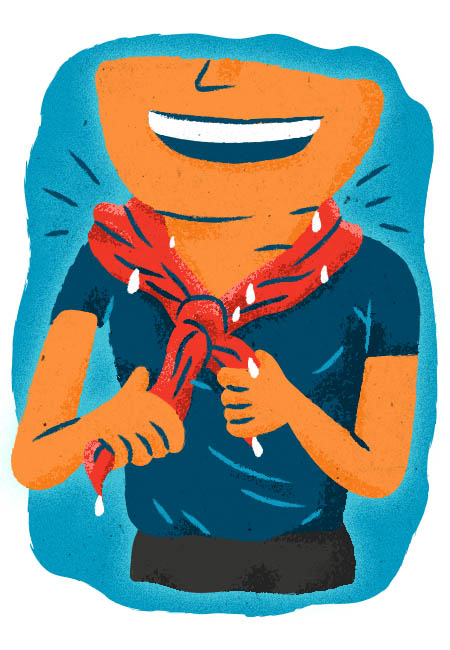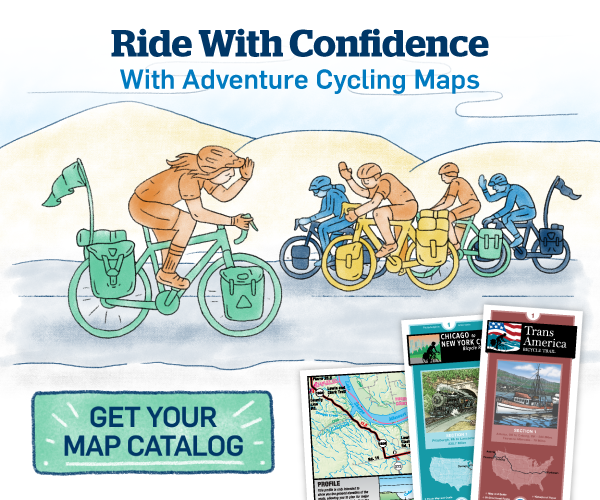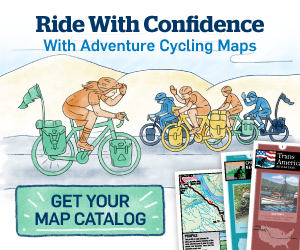Staying Cool While Touring in the Heat
We can’t control the elements. It’s part of what makes bicycle touring so exciting: we set off on long-distance journeys, unsure of what conditions we’ll be riding in.
But if you’re planning a summer bike tour across the United States or a trip to the American Southwest, you know you’ll be in for some “scorchers.” Here’s how to keep cool while cycling in hot weather.
Wear the Right Gear
This is not the time for bucket-style helmets and thick black cycling jerseys. You’ll want maximum airflow and light colors to keep the heat at bay. Riding a bike creates a natural breeze, so use that to your advantage by wearing clothes and a helmet with plenty of ventilation.
Slather on the Sunscreen
You might be a fan of “cyclist’s tan,” the severe tan line that makes it look like you’re still wearing a pale jersey long after you’ve removed your shirt. But you won’t be a fan of the heat radiating from your sunburn!
It’s a miserable experience to be tucked into your sleeping bag after a long day in the saddle, feeling your skin throb from too much sun exposure. Cover up with cooling layers, or use plenty of sunscreen, especially on your thighs and calves.

Evaporative Cooling
One of my favorite tricks on long bike tours is to wear a wet cotton bandana around my neck. There are a few “cooling spots” on the human body, where the blood vessels are closer to the skin, and the neck is one of them. A wet bandana will dry while you ride, creating an evaporative cooling effect on your neck. The bandana can dry pretty fast, especially in the desert, so it’s necessary to remoisten it at any opportunity (gas stations, cafes, public drinking fountains, etc).
There are other “cooling spots” on our bodies, such as the inside of your elbows and the backs of your knees, but I don’t recommend wearing wet clothing over those. Damp fabrics can lead to chafing.
Stay Hydrated
The key to staying ahead of dehydration is to drink a little at a time but frequently. Don’t wait until you feel thirsty, or it may be too late! Drinking electrolytes, as well as plain water, is a good idea to replenish the essential minerals and salts that you lose in your sweat. If not replenished, losing these nutrients can lead to muscle cramps.
Water tends to heat up in bottles throughout the day, so if you have an opportunity to fill your bottles with ice, do so! The cool drink will be refreshing later on.
Avoid Midday Riding
The hottest part of the day tends to be around 3 pm, depending on cloud cover and terrain. It’s a good idea to stop and take a long break (preferably somewhere indoors with air conditioning!) when you feel like you’re beginning to roast.
In some areas, such as the desert of the American Southwest, it’s advisable to plan a long pitstop in the middle of each riding day to take a break from the sun. Riding early in the mornings and late into the evenings will help to make up for the lost cycling time, but always use bright bike lights and reflective clothing to remain visible to drivers.
Post-Ride Recovery
Continue to drink water and electrolytes after your daily ride. If you have a recovery-specific formula, that’s even better. Many companies offer recovery-specific powders that can be mixed with water, and these powder packets are lightweight and easy for touring cyclists to carry.
Take a cold shower to lower your core temperature, or if there’s a pool, lake, river, or other bodies of water available, now’s the time to go for a swim!
Stay cool out there. And if you have any other tips for riding in the heat, we’d love to hear them in the comments below.


Comments
I made a evaporative bicycle "air conditioning" system by mounting a garden sprayer containing 2 quarts of water on my bike. The nozzle is aimed at my chest so when i depress the valve a spray of water moistens my shirt. large droplets of water are preferred as fine droplets tend to be blown away. I just got back from a 3 mile ride at 100 degrees and was not overheated on return. The evaporation of water from cotton cloth in direct contact with skin is an effective system for cooling a cyclist and can be generally recommended for use in areas that have a relative humidity of 60% or less. Sorry, will not work in Houston! The garden sprayer must be new and verified to be unused with pesticides before use. This method of cooling is extremely effective at cooling a cyclist provided the relative humidity is below 60%. I highly recommend this approach in areas where the humidity level is appropriate.
Happy Cycling
I use a camelbak and fill it completely full of ice, then add water, or fill half, freeze and top off with water. Then I put it in a customized cold bag, (regular cold bags from the grocery store, cut down to size), and place it in the backpack. I live in south Texas and regularly ride in blazing temps. This keeps my ice frozen over 4 hours. Sometimes I have had to remove it from the cold bag to thaw a bit after a couple of hours because I was down to ice.
Fill your water bottles about 1/3 full the night before and put them in the freezer. Then fill the rest of the way with H2O before you ride.
In hot, humid climate I usually wear loose-fitting clothing. This allows for air flow which aids in cooling. Long sleeves to prevent over-exposure to sun, longer shorts for the same reason. Add to that a wet bandana around the neck and you're set.
I carry my drinking water in a hydration backpack. It has a wide mouth. When riding from home I freeze big "ice cubes", using 1 pint cottage cheese containers filled half full. They last much longer than regular ice cubes. I carry extra water in a bottle, which I love to pour on my head when I don't need it to drink.
Cover up. Sun sleeves, sun legs, neck gaiters. If you get hot, wet them down.
Although I ride in Alabama summer heat, I'm heat sensitive. I use a camel back in summer heat. Fill with ice at every opportunity. It keeps my back cooler. Wet the inside of the c/b to keep cool. I also have home made "ice chests" made from bike bag lined with Styrofoam sealed in Mylar. Fill with ice and use inside cool towel/bandana around neck. Melting water keeps you cool too. Yes, ice will melt, but it does work...for awhile. It's better than nothing in 90+ riding!
When riding across the desert in the summer I filled my water bags with ice (an 8-lb bag is approx 1 gallon), then topped them off with water and more ice until full. When I stuck the back down into my pannier the water stayed cool for several hours.
Wow, Sam! You were like a rolling cool-water-dispenser. It's amazing how fast that ice can melt in the desert, but it's worth it for some refreshment.
Forgot Password?
Enter your email address and we'll send you an email that will allow you to reset it. If you no longer have access to the email address call our memberships department at (800) 755-2453 or email us at memberships@adventurecycling.org.
Not Registered? Create Account Now.